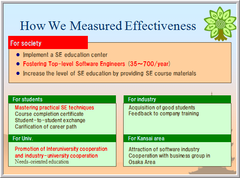What has IT SPIRAL done?
One of the key questions for a project such as this is how to measure the effectiveness, as suggested in Figure 5. For the IT SPIRAL project, the most important measure is fostering top-level software engineers who can demonstrate that they have mastered practical software engineering techniques. A related important result is the promotion of cooperation between the universities and industries in developing top-level software engineers.
First, it has developed a common one-year curriculum for software engineering masters students in the Kansai area that includes emphasis on basic skills, advanced topics, and practical capabilities. Second, it provides a model for university and industry collaboration in such education, combining local classes, a shared DVD library of lectures, and bi-weekly common intensive practical sessions. Third, it has raised a number of questions about the best way to share materials, projects, assignments, tests, and similar parts of the educational experience.
Our experience with the shared DVD library indicates that teaching assistants can easily show the DVDs to a class, freeing the faculty from repetitive lectures. Copying the DVDs and sending them to other universities allows a single expert to reach many more students. Our experience also shows that simply showing the DVDs is not very effective. However, having the teaching assistants stop the DVDs at natural pauses and ask the students to discuss the main points or any questions increases the interest and involvement of the students with the material significantly. Structured interaction lets the students teach each other and develop deeper knowledge of the material being taught [7].
One measure of the influence of IT SPIRAL is the distribution beyond the core students. For example, one report indicates that while 42 students are involved in the core lectures, 253 students from the nine universities have used the DVD library, and 1293 students have taken part in the fundamental courses. Additionally, the DVD library and other teaching materials are already being requested and loaned to other institutions of higher education such as the Osaka City University and Keio University graduate schools, and industry. Also, there are plans for an international symposium in January 2009.
Table 2 shows selected results from a recent survey of faculty and industry leaders involved in the project about some key parts of the IT SPIRAL project:
| PURPOSE |
|
|---|---|
| DIFFERENCES |
|
| RESULTS |
|
- [7] A. Pyster. Graduate Software Engineering Reference Curriculum [GSwERC] Version 0.50, Stevens Institute of Technology, October 2008.
